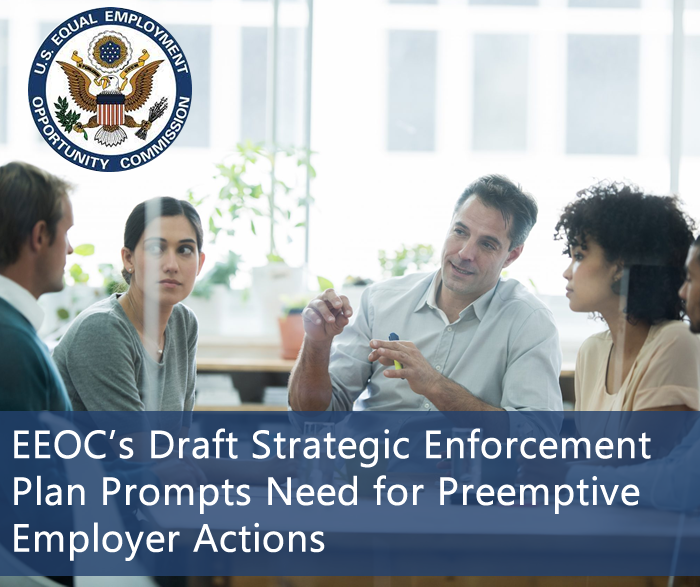EEOC’s Draft Strategic Enforcement Plan Prompts Need for Preemptive Employer Actions

The EEOC has issued a very clear reminder to employers that forewarned is forearmed.
On January 10, 2023, the EEOC published its Draft Strategic Enforcement Plan for 2023 – 2027. The plan, which can be found here EEOC Draft SEP 2023-2027 outlines the workplace issues the commission intends to target over the next five years.
Of particular interest is a focus on the emerging issues relating to the use of artificial intelligence (AI) in the workplace. This is in addition to on-going enforcement efforts relating to employees with disabilities and criminal histories as well as protections for the LGBTQI+ community, older workers and employees with limited literacy or English proficiency. The draft plan also indicates continued focus on discriminatory pay practices.
For a summary of the draft plan and some practical advice regarding self-audits, please continue to our blog.
EEOC’s New Enforcement Priorities Show Need for Employer Self-Audits
Employers are getting a look at the Equal Employment Opportunity Commission’s (EEOC) new enforcement priorities, and the agency’s draft plan shows a need for employer self-audits to guard against systemic discrimination, according to an attorney advising employers.
The EEOC’s plan, which covers the years 2023-27, also signals a need for employers to examine how their use of artificial intelligence (AI) may create barriers in recruitment and hiring.
Nita Beecher, an attorney with FortneyScott in Washington, D.C., says employers should consider doing self-audits on their compliance programs to ensure there are no systemic discrimination issues in their employment processes since both the EEOC and the U.S. Department of Labor’s (DOL) Office of Federal Contract Compliance Programs (OFCCP) are focusing on systemic discrimination.
“At the very least, employers should do a privileged pay analysis, and if they find unexplained pay disparities, they should address them now,” Beecher says. With the new requirements in some states that companies publish pay rate ranges, employees will be more aware of what new employees will be paid.
In addition to looking for discriminatory pay practices, employers need to examine their use of AI, Beecher says. “Employers should focus on the fact that the EEOC is moving forward to regulate the use of AI in employment.”
Beecher notes that the EEOC is to hold a hearing on the use of AI on January 31. It won’t issue new guidance on AI, however, until it gets a third Democratic commissioner on board.
Kalpana Kotagal has been nominated for a seat on the five-member commission. Currently, the EEOC has two Democrats and two Republicans with one vacant seat. If confirmed, Kotagal will provide a Democratic majority.
Beecher says that once Kotagal is confirmed, the EEOC will move to collect employee pay data once again.
During the period that the plan is up for public comment, Beecher says she expects employers will want to provide feedback on pay data reporting and the impact AI guidance might have on hiring and recruitment.
Enforcement Plan Contents
The EEOC is charged with enforcing federal laws against employment discrimination based on race, color, religion, sex (including pregnancy and related conditions, gender identity, and sexual orientation), national origin, age (40 or older), disability, or genetic information. The Strategic Enforcement Plan is a multiyear plan establishing the agency’s priorities.
The plan’s executive summary notes that it will:
- Expand the vulnerable and underserved worker priority to include additional categories of workers who may be unaware of their rights under equal employment opportunity laws, may be reluctant or unable to exercise their legally protected rights, or have historically been underserved by federal employment discrimination protections;
- Refine the recruitment and hiring priority to include limiting access to on-the-job training, pre-apprenticeship or apprenticeship programs, temp-to-hire positions, internships, or other job training or advancement opportunities based on protected status;
- Recognize employers’ increasing use of automated systems to target job advertisements, recruit applicants, and make or assist in hiring decisions;
- Update the emerging and developing issues priority to include employment discrimination associated with the COVID-19 pandemic and other threats to public health, violations of the newly enacted Pregnant Workers Fairness Act of 2022, and technology-related employment discrimination; and
- Preserve access to the legal system by focusing on overly broad waivers, releases, nondisclosure agreements, or nondisparagement agreements.
Next Steps
The agency is accepting comments on the plan through February 9. Comments must be submitted electronically to www.regulations.gov/document/EEOC-2022-0006-0001.
After the comment period ends, the final plan—including any revisions based on public feedback—will be voted on by the full commission.
Article courtesy of content partner BLR. Author Tammy Binford writes and edits news alerts and newsletter articles on labor and employment law topics for BLR web and print publications.